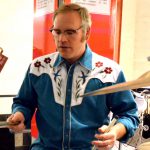
This Member Update was provided by Matthew Cook, Head of Unique Collections and Scholarly Communication at the J.S. Broome Library, California State University Channel Islands.
The “build it and they will come” approach is widely accepted in the library community, particularly in the area of digital collections. There is, at times, little critical analysis given to collection development, digitization efforts, or information literacy instruction in regard to how these hard to serve but research-rich materials might be used in the classroom. Instead, there exists a benevolent know-it-all expert determining which collections warrant preservation, digitization, acquisition and, ultimately, attention. At California State University Channel Islands (CI), the users—teachers and students—are the focus of all digital and special collection activities and we’ve devised innovative ways to encourage both students and faculty to engage these materials as well as foster their appreciation, awareness, and use on campus. I’d like to share one collection that illustrates this notion.
In the fall of 2013, we received an archive of documents, images, and ephemera from the Ventura County Commission on Women (VCCW). This NGO advised the County Board of Supervisors on issues affecting women and girls in Ventura County, which makes their collection an important resource for any student studying this subject at CI. Analysis of the collection with sociology faculty suggested that this collection would and could be used by CI students immediately. The library found a willing researcher in Cassandra Ludwig
Cassandra Ludwig, a senior at Channel Islands, is looking to leave her mark on Ventura County. To do so, she argues, she has to learn more about the county, so she decided to do a little research. The sociology major is enrolled in University 498, a self-directed research class that I “teach.” Cassandra is using the digital archives to examine the relationship between VCCW published reports and legislation debated and passed by the Ventura County Board of Supervisors, which should indicate the effectiveness of the Commission.
Cassandra says, “I want to do research to expand my knowledge. This class and the VCCW collection represent a great opportunity to learn more about the community. I live here and I want to know what is going on.”
She adds, “I get to learn about things, things I didn’t even know that I wanted to learn about.” It is this idea of exploring the unknown that excites Cassandra, who says, “I like reading articles that don’t go hand in hand at first, but do later. Making those connections leads to gaining new knowledge.”
The senior looks forward to applying her knowledge and skills to graduate school and, she hopes to serve Ventura County by working at a local not-for-profit. This, despite the two things that she doesn’t like about doing research: “deadlines are scary and you’re never done.”
I am serving as her teacher on this project in name only. Research is self-directed since, as Cassandra points out, she is creating new knowledge. Although I am there to answer questions and try to create a framework for her, it is Cassandra that will be determining which topics she will focus on and how her project will unfold. It really is exciting, for her and myself. And it is the very reason that we collect and preserve unique collections in the library–they benefit students and their education.
Cassandra says that to be successful in conducting research, “You need to be determined, willing, and optimistic.” In light of her nearly completing her undergraduate education, coupled with the fact that she has a clear plan ahead of her, it appears as though she has the skills to be an effective researcher.
Since the UNIV 498 class is a credit-bearing course, it was agreed that Cassandra’s deliverables would consist of essays about the VCCW, which would contextualize the digital collection. Thus, in addition to the digital collection, there will be a timeline, history, and essay on the relationship between the VCCW and the county government.
Digitizing collections that students will use is an easy concept to understand. What makes this special is that CI only digitizes collections that we know students will use. And to strengthen that concept, the librarians teach credit bearing courses for students using unique collections. Perhaps instead of “Build it and They Will Come,” it should be “Build it and They Will Come—or Fail the Class.”
